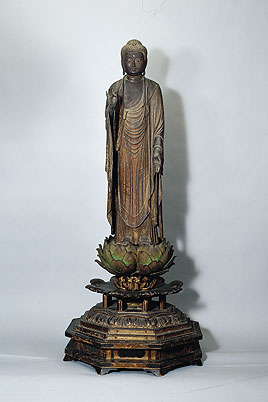
Ritual and Religious Objects
 |
Amida Nyorai (Buddha Amitabha) Japan Kamakura period (1185-1333), mid- to late-13th century Cypress wood with traces of pigment and cut gold leaf with inlays of crystal H. 47 in. (119.4 cm) Asia Society, New York: Mr. and Mrs. John D. Rockefeller 3rd Collection, 1979.204a-b |
Standing on a lavishly carved lotus pedestal, this sculpture of Amida Buddha (Sanskrit: Amitabha; the Buddha of the Western Paradise) shows the mudra, or hand gesture, of raigõ. Amida displays this mudra when he descends to welcome dying believers into his Pure Land, the Western Paradise. During the late Heian (794�1185) and Kamakura periods, when belief in Pure Land Buddhism was popular in Japan, paintings and sculptures in the theme of raigõ are known to have been placed at the deathbeds of devotees. The inlaid crystals used for the eyeballs of this sculpture give the figure a feeling of vitality. Lightening patterns (raimon) and round-flower patterns (dankamon) in fine gold lines (kirigane) compose the beautiful ornamentation on Amida�s garments.